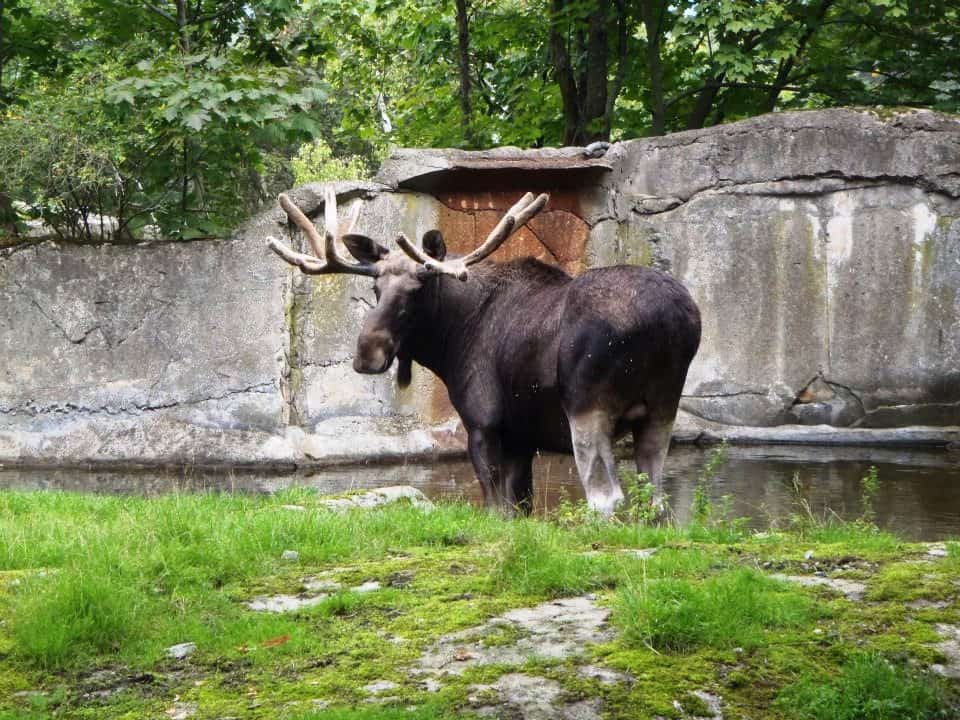
O, the enchantments of Fiordland: Time and again I have been drawn back to this lush green Eden questing after one of these surviving prehistoric giants, which though sundered from their ancient homeland in the vast boreal forests of the North, still linger there today.
For me it is a tale which began when I picked up a copy of Australian Deer back in the 1990s on whose cover this wonderful grainy image gazed out at me:

Instantly I wanted to put myself in that picture. My daughter Merrin even Photoshopped me into it as a birthday present! The article which accompanied it introduced me to this man, Eddie Herrick whose search for this gentle giant in the vastness of Fiordland with his guide Jim Muir consumed so much of his life. Every year for thirty years he spent three months there, searching for them: ten whole years of his life! Even more of Muir’s. On three occasions he was rewarded with such an experience as the photo above shows: two bulls and a three-legged cow!
The one above was the bull moose he took in 1934 in what is now eponymously Herrick Creek in Wet Jacket Arm, Dusky Sound. I guess he is about at the top of the small lake in the lower section of the creek. You can see he was about the age (50-ish) I was when I began my search, so I had no feeling that what I was to undertake was impossible. Though I have found that it is very nearly so, and anyway supremely difficult, every year a powerful magnetism draws me thither.
Jim Macintosh’s cow moose 1950s:
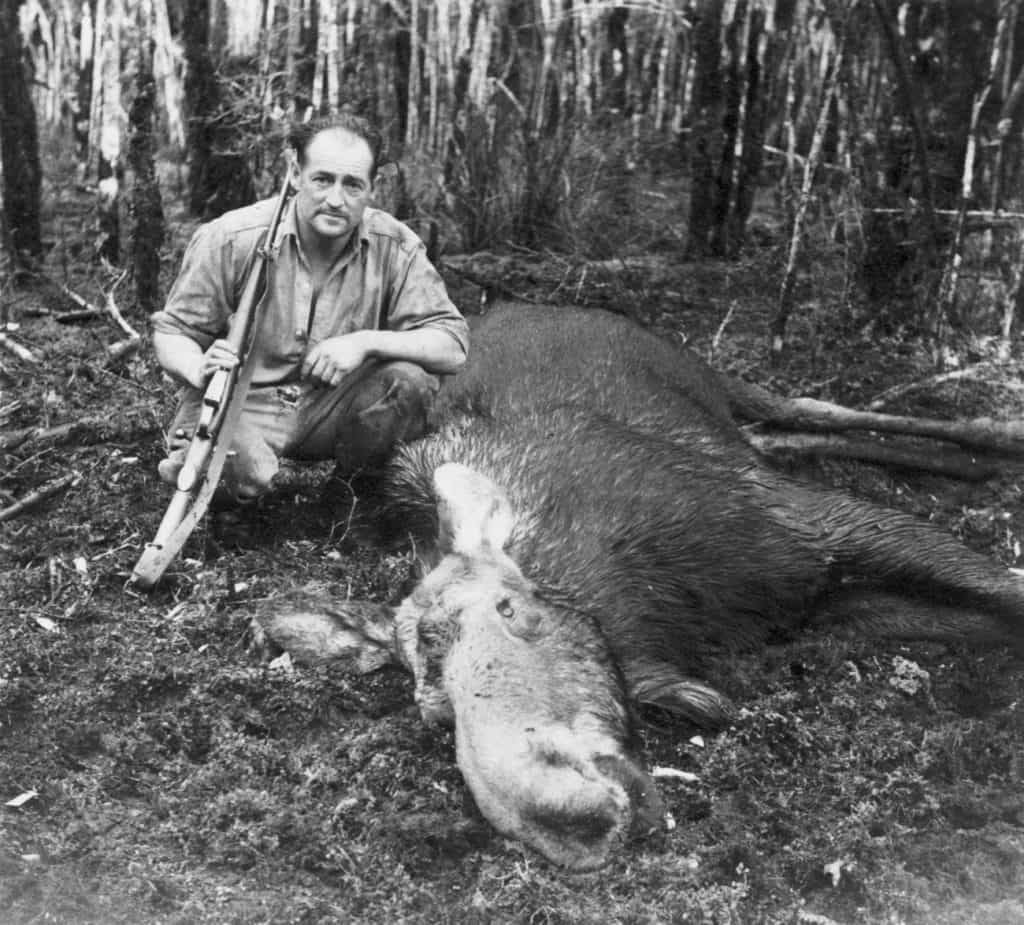
Shortly after I read the article I acquired Ken Tustin’s wonderful book and video ‘A Wild Moose Chase’, Max Curtis’ ‘Beyond the River’s Bend’ and Ray Tinsley’s ‘Call of the Moose,’ each being about NZ’s famous or fantastic moose herd – and all of which I devoured eagerly. I was hooked.
At the same time I read several other books about moose in general. I was soon becoming an armchair expert on these giant creatures. Of course I wanted to journey to New Zealand to have a look myself. I never imagined I would have enough money to see them in Canada where you have to push them off the back porch – anyway, like Mark Tapley of Martin Chuzzlewitt, I prefer a challenge!
My fiftieth birthday came and went. My wife, Della purchased me the first brand new deer caliber rifle I had ever owned, a Browning Lever Action (BLR) in .308 calibre. What a wife! She also encouraged me to make the trip as soon as I could before I was too old to do so. Hang the expense! I planned to go in the New Year 2000; it ended up getting pushed out to nearly the end of February. Still an excellent time to be in Fiordland. Two sambar hunting mates, Brett and Michael got wind that I was going (originally by myself) and decided they needed to chaperone me!
Lots of planning, particularly of gear ensued. You would think we were C18th century explorers heading off for darkest Africa! All the same I was only going away from home for eight days. I really don’t know how Della was able to manage to look after the farm/s as well as go to work then – we had hundreds of acres and well over a thousand sheep scattered over half a dozen different properties – but she did. I think we planned on having five days ‘moose hunting’ at Supper Cove.
Cow moose snapped by Max Curtis, Herrick Creek, Wet Jacket Arm, Dusky Sound 1950s
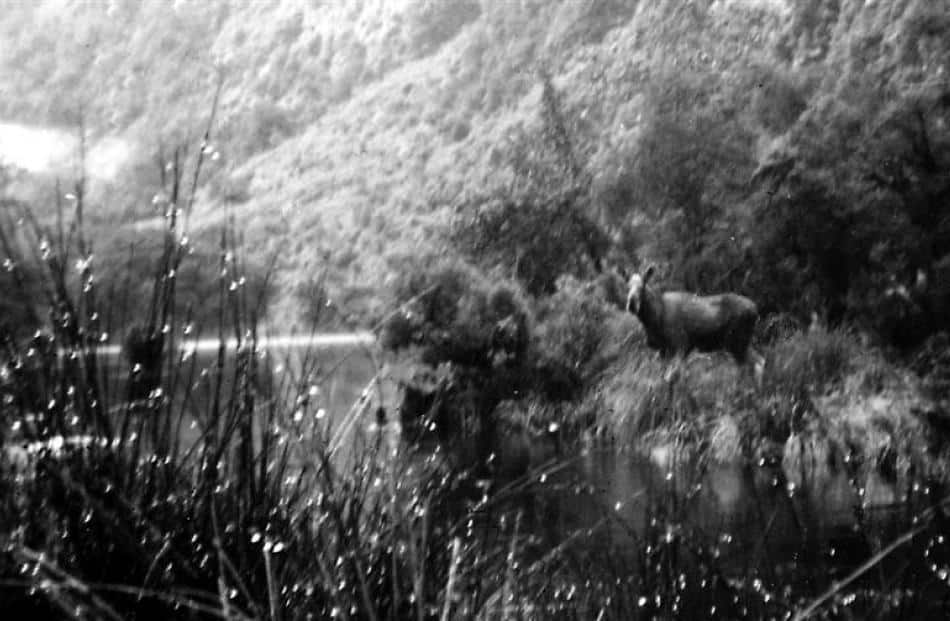 We landed in Christchurch then drove down to Te Anau. Michael at least had never been to NZ before and Brett had not seen Fiordland. This was a sentimental journey for me as Della and I had lived in Christchurch in 1975 and had toured all over the South Island together on a CB 250cc Honda motorcycle. I had never been anywhere without her before, so I confess I was missing her as we traveled down the island. Everything i saw I wanted her to see too. She would have to wait another thirteen years for her turn! She is a patient person.
We landed in Christchurch then drove down to Te Anau. Michael at least had never been to NZ before and Brett had not seen Fiordland. This was a sentimental journey for me as Della and I had lived in Christchurch in 1975 and had toured all over the South Island together on a CB 250cc Honda motorcycle. I had never been anywhere without her before, so I confess I was missing her as we traveled down the island. Everything i saw I wanted her to see too. She would have to wait another thirteen years for her turn! She is a patient person.
We had organised to fly in with the ‘Wings on Water’ float plane to Supper Cove and so begin our search from there. This was the first time Michael or I had ever been in a small plane. As I have a problem with heights (even to changing lightbulbs!) I felt that I would have to close my eyes, grit my teeth and endure, but as it turned out I loved it, and would pay to do it again and again!
The high flight over Lakes Te Anau and then Manapouroi, glimpses into icy sunless valleys to the north, a panorama of Doubtful Sound, then the plunge through Centre Pass and a slow descent down the mighty Seaforth valley over towering Tripod Hill and the perched Lochs (Gair & Maree), past the southern home of the moose (the Henry Burn) and on to the glittering expanse of the vast Dusky fiord is a journey worth a million dollars (but only costs NZ$330 – 2017!)
Percy Lyes NZ bull moose 1950s
 We had all been hunting sambar deer in (what we thought of as) rough country in Gippsland for many years, so reckoned we could tour the Fiordland forests in much the same way. For example, It is just a handful of kilometres (‘as the crow flies’) from Supper Cove over the range to the mouth of Herrick Creek. We foresaw that as a day hunt. In fact it is an arduous trip of at least four days return which I am yet to complete. Being just shy of 70 now, I am doubtful I ever will, but next autumn I know I will feel differently once more!
We had all been hunting sambar deer in (what we thought of as) rough country in Gippsland for many years, so reckoned we could tour the Fiordland forests in much the same way. For example, It is just a handful of kilometres (‘as the crow flies’) from Supper Cove over the range to the mouth of Herrick Creek. We foresaw that as a day hunt. In fact it is an arduous trip of at least four days return which I am yet to complete. Being just shy of 70 now, I am doubtful I ever will, but next autumn I know I will feel differently once more!
Supper Cove is at the head of Dusky Sound, the largest fiord in NZ. It was discovered and named by the same Captain Cook as the East Coast of Australia. August 2018 will be the 250th anniversary of his setting out. The first European structures in NZ were built there – even the first house, surprisingly by the shipwrecked crew of another ship also (like Cook’s) called the ‘Endeavour’.
The Supper Cove hut is adjacent to a lovely little beach where the Hilda Burn flows into the top of the fiord just South of Supper Cove itself – which is formed by the mighty Seaforth River flowing into the head of the fiord, creating a shallow semicircular cove perfect for flatfish. You can walk across this cove at low tide from the northern end of this little beach just past the helipad, but there is a deep gut formed by the Hilda Burn flowing in, so if you want a drier crossing you are better to walk up the track past the Hilda Burn before you cross.
Brett walking across Supper Cove on a low-ish tide:
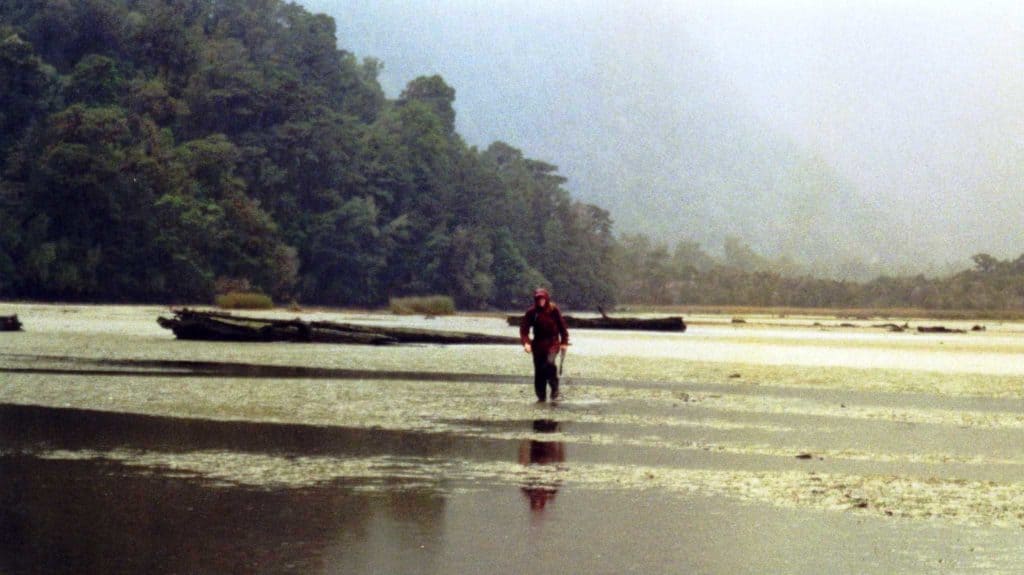
If you wish to look for moose (or red deer eg during the Roar) along the Seaforth the three huts (Supper Cove, Loch Maree and Kintail) are good bases from which you can make daily forays up the many ‘Burns’ and onto the slips searching for these elusive monsters which (especially in the warmest days of summer) I believe often lie cooling themselves in the deeper pools. At other times they are likely to be too widely dispersed for you to ever encounter one, but they do particularly like the fuchsia regrowth on slips. If you are there at the end of February as we were on this occasion, you might even hear a bull moose call (as we did on the last day of February 2000), or perhaps even a cow answer him!
Initially at least Michael decided he would make the Henry Burn his own, whilst Brett and I focused our attentions on the Hilda and ‘Waterfall’ Burns. We arrived around lunchtime and reckoned impetuously we had enough time to check out the Hilda Burn quite thoroughly that afternoon. Of course we had not gone more than 300 metres before we realised that our times/distances would be very different than we had imagined.
If you try to follow the Hilda Burn upwards you realise quite soon that your way is blocked by a vast angry cataract that it is impossible to pass or climb. You have to go up one side or the other. The first afternoon we ascended on the true right bank (looking downstream – that is the convention). About 200 yards above the existing hut there is the ruins of an earlier hut. The first thing I knew about it was that I had tripped over a barbed wire ‘fence’ hiding in the undergrowth badly tearing my shin- something which you most certainly are not expecting in the enormous wilderness of Fiordland. No-one I have encountered seems to know anything at all about this ruin, but there is some wire, netting and sheets of iron there which might come in handy sometime if you know they exist.
The cataract in the Hilda Burn

Here are the remains of the old hut – and a ubiquitous fantail.

Even just traveling this far up the ridge you need to be alert to keeping the position in mind of the roar of the water falling in the Burn, as when you turn to descend you will swiftly realise that the country fissures and falls away in all directions with very steep, narrow guts which it is well-nigh impossible to traverse laterally, something which the deliberate focusing on ascent is likely to lead you to ignore. It is incredibly easy to become ‘bluffed out’ in Fiordland – meaning that you may relatively easily ascend but when descending not be able to find or see a way down at all. You have to pay incredibly close attention to the route you took on the way up.
We climbed above the second hut, hauling ourselves over rocks and tree roots through vastly wet, dense terrain until the roar of the water diminished to the point we judged we could safely descend into the upper Hilda Burn. As we angled down into it at one point we had to climb a monstrous fallen log about the height of my nose (say about 5′), so that I could not actually see the top of it. When I had clambered my way up onto it, I was astonished to find right on top of it fresh moose droppings! Boy, they are big beasts! It was completely obvious what they were, as everywhere in the forest there were red deer droppings – pretty much indistinguishable from sambar droppings (being similarly sized deer ie approximately jelly bean sized).
The enormous moose droppings left and centre and normal sized red deer droppings right and below them (above the leaf).

These moose droppings were nearly as large as my thumb in comparison. Brett picked up some red deer droppings and handed them to me so that I could photograph the two so they could be compared. Back then practically no-one believed that moose had survived in Fiordland into the C21st. Most believed they had died out soon after Percy Lyes had shot his bull moose back in the early 1950’s. But here we were only an hour or so into the Fiordland forest and we had in our hands (so to speak) proof that a moose had passed this way within the last day or two (the incessant rain makes smart work of any ‘sign’ in Fiordland).
Above is a photo of those fewmets. My apologies for the quality of the photos in this post. In 2000 I had the latest ‘Advantix’ film camera, but technology sure marches on. I thought the snaps I took back then were just brilliant, but I am embarrassed by their poor quality now, as I am also becoming embarrassed by the present quality of my digital camera compared with the results from Della’s Samsung Galaxy 7’s. Mind you the forests are so dark, it is very difficult indeed to get good photos. Maybe if you are an expert (and can afford to lug along a few kilos of photography kit), as I am neither…
We beat our way down towards the burn following the tracks possibly of an extremely large red deer. Certainly as big as the biggest sambar stag anyway. He arrived at the stream just above a wide clearing on the true right bank caused by one of the innumerable slips which beset that country and which create most of the new feeding opportunities for the moose herd. Unusually (most are covered with fuchsia regrowth) this slip had been kept quite grassy (apart from a few coprosma) by the innumerable red deer, of which there was lots of sign. But also, cutting right across the bottom of the clearing were the huge tracks of a moose. With feet as large as a cow’s or horse’s he had sunk almost a foot deep as he crossed some days ago. The smaller red deer tracks in comparison had made much less of an impression, and were everywhere to be seen and compared There was no comparison. Clearly these tracks were from a vastly larger animal, which in that situation could be nothing but a moose.
The clearing on the true left side of the Hilda Burn.

Eddie Herrick shot an ancient three-legged cow moose (I think) in the Hilda Burn in the 1930s. She was likely the one who clearly broke its leg when they were tipped out off the boat in Supper Cove. You can see that one has a broken leg in the photo of the herd standing in Supper Cove looking mournful – poor things had been raised on lucerne and grain! Amazingly, though she must have lost the leg (to gangrene?), she had survived in that most moose inhospitable terrain for nigh on thirty years. Knowing that they were that tough I had many doubts that they had somehow mysteriously died out sometime after 1950. Here was one who had walked across this clearing in the last day or two, clearly making this valley and its surrounds its home!
Brett in the Hilda Burn.
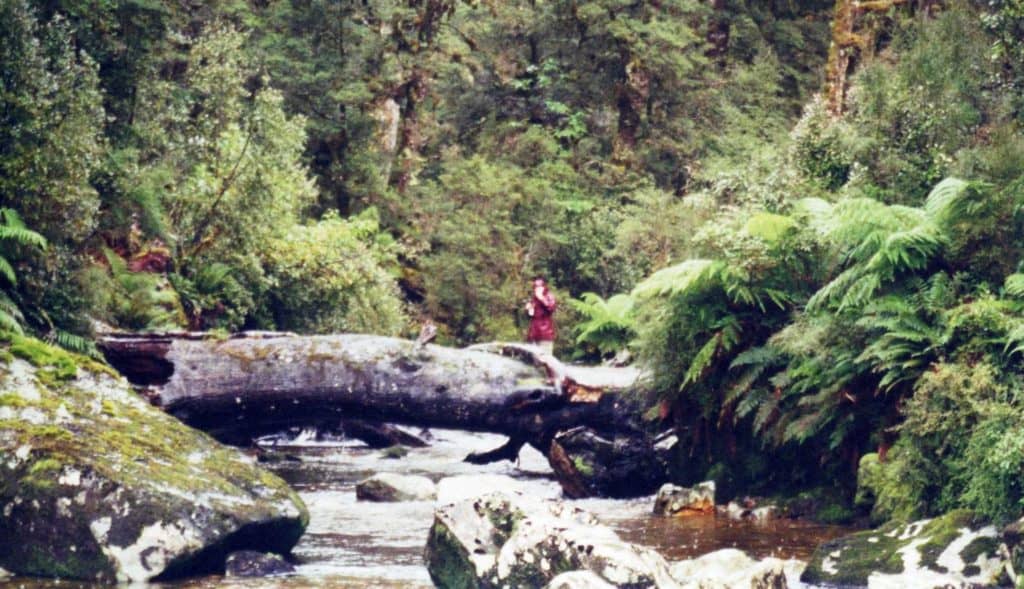
Also on this clearing there was a small tree or sapling (I suppose 3″ in diameter) which had clearly been pushed over and stripped by something, the bark on the top also having been chewed away. I remember wondering why the tree had ‘fallen’ at such a strange angle, as if an immense wind had pushed it over, so that its top was no more than a metre above the ground. I guess it was nearly twenty years before I was informed by (Ken Tustin) that this behaviour of walking trees down is a favourite moose feeding strategy. On this trip I saw it several times – and I have seen it many more times since. It is unmistakable moose ‘sign’.
By the time we had descended to the stream it was becoming sufficiently dark that we needed to turn right round and head back unless we wanted to spend our first night in Fiordland sitting around in our raincoats in cold, wet bush. For advice about that, see: http://www.theultralighthiker.com/raincoat-shelter/ You should definitely avoid that situation. My advice is to carry a hammock and tarp so you can spend a dry night in the bush. At the very least a lightweight umbrella. Montbell have one as light as 85 grams – not a lot to save your life!
Looking down from the Hilda Burn.

I guess it was the next day we decided, (it having been too difficult scrambling up the true right bank) that we would find a way up the true left bank. Let me tell you, it was no better, if not worse. It is even harder now! There is some very steep going, a huge tangle of fallen trees, at least one waterfall to traverse – just to get above the cataract. And you had better remember just how you got there, as when you are coming back down you will find that the way up was the only way! Just that happened to us. It was only that when we became ‘bluffed’ we sat down for a smoke or a bite to eat, to ‘study’ on our dilemma, and when we sat down that we realised that the last little bit we had had to crawl up – a reality which became apparent when we got low enough to see where we had come from under a large log. A cup of tea or a smoke (or sleep on it) are always good strategies if in doubt.
We saw a few red deer on the slip as we passed. They weren’t particularly alerted to our passage. We could easily have harvested one. The heavy cover of moss everywhere in Fiordland and the sodden nature of everything sucks up a lot of sound. Mostly all you can ever hear is water moving, falling, sloshing, dripping…There is very little birdsong (well, there are very few birds) but even so their song does not carry as it does in Victoria. Sometimes you can see that they are singing even quite close up, say less than 20 yards, yet are unable to hear them.
On this or another occasion Brett was walking up the true right bank as I walked up the true left. At one point I wanted to attract his attention, so I whistled. No response. Then I blew a blast on my ultra loud Fox 40 whistle which the manufacturers reckon you can hear up to a mile away! No response. He was perhaps 40 metres away. The sound was just soaked up by the forest. And he is not deaf like I am. You can see how, the folks who have shot a moose in Fiordland pretty much universally just stumbled on it (usually very close to a creek) when it stood up, they went, ‘Crack!’ and down it went. End of hunting story.
Walking high up in the Hilda Burn:

There is a section of morass to cross (on the true left bank). It is quite difficult going, and remains so. These morasses are ubiquitous in Fiordland and very dangerous. I can well believe you can get stuck in them and be unable to extricate yourself. You can very suddenly plunge (right on the edge) up to your hips – as I have done many times. If you can throw yourself backwards as you fall in it is easier to get out. Another grave danger of walking in the Fiordland bush is that all these large gullies are actually the moraines of ancient glaciers. Underneath they are boulder fields. And in many places not very far underneath. You need to test each step before you put your weight on it to ensure that you are not going to plunge downwards into a huge crevasse – as I did on the fourth day trying to ascend the ‘Waterfall Burn’. Downwards over my head in an instant. Fortunately I did not break anything except my dignity and I was able to climb back out again. Probably the gullies are worst for this than the ridges.
I cannot now remember whether on the particular day I am relating I was alone in the valley – as I have been several times since – or if Brett was somewhere else in the valley. Anyway, I had dropped down into the stream by myself and was wading along in it – as that was the easiest going, Every now and then getting out, then getting back in again. I’m sure you know what thick difficult going is like. There came a point where as I was rounding a bend in the stream, (the banks being nearly as high as I am) something very large and dark surged up and thundered off in a cloud of spray further up the stream, giving me just the barest glimpse of it. All I could say was that it was not a bull, as I would have been able to see its antlers above the banks of the stream.
I followed it (as quietly as I could – spooked things will often halt to look back and see what it was which frightened them) when shortly the stream split in two. Where the two streams joined there was a large patch of sand, and clear as day in the sand were the unmistakable prints of a moose. They were very nearly as large as a cow’s prints, and they had the ‘signature’ dew claw marks a couple of inches behind the main hoof prints such as only moose amongst deer kind normally make. I would have a photo of them only when I was coming back down again some time later, the rain had all but blurred them clear away – it does rain lots in Fiordland. Expect to get very, very wet, even in Goretex such as I was wearing.
It had crept off upwards into a large swampy area lying between the two streams which did not show up on the topographic map. It must have been very difficult to get good (and accurately interpret) aerial photography in Fiordland. I followed the beast around in this swampy area for I guess about an hour, each circling the other trying to get a look, sometimes seeing a bit of leg perhaps. The water was ankle to knee deep, and there were many small islands each with a vast tree protruding from its centre and surrounded by lowish bushes. The cloud cover came half-way down the trunks of the trees. A prehistoric landscape for a prehistoric creature. A couple of times I could have taken a shot at it through vegetation – it was often clear just where it was – but I never (nor should you) ever do such a thing. A deer missed is one thing; a dead mate is missed a long time!
Alas, once again light was going to beat me. I had to break off the chase or I would be spending a terrible night out in this saturated forest. There is just no way you could make your way down in failing light or darkness. Having had so little trouble ‘putting up’ a moose, I was also optimistic that I might do it again. There is no end to human folly! We had been incredibly lucky.
It disappeared somewhere up there into the head of the burn, and it is no doubt there yet!

After breakfast next morning we were all standing on the edge of the verandah of the hut looking up the Cove, enjoying a smoke (some people still did then – Michael anyway) or a cup of coffee, when a large animal started calling. I thought it sounded something like a cross between a gigantic koala bear and a camel. It was definitely not a red deer (which I had heard many times before) or a wapiti (which I have also since heard – they really do bugle. Eerie!) – and it was definitely not a bird of any kind, though there were many Canada geese on the Cove (and we had heard their call many times too).
Even though we had been there then for a couple of days, we had still not (instinctively) adjusted our hearing’s ability to pinpoint where a sound came from to Fiordland’s conditions (I have already mentioned the episode of the whistle). It takes a while for perception to adjust. Another example is one’s ability to actually focus on these NZ mountains. They are so much steeper than ours in Australia, they appear to our perceptions to be closer and/or you find yourself actually unable to focus on exactly where they are. Things can seem blurry, eerie. When you go there you will see what I mean.
So I guess we can be forgiven for being unable to work out exactly where the moose was (we were quite sure that was what it must be – and we were right). Our Australian senses made us overlook a flat area near the mouth of the Hilda Burn nearby (too close). It was clearly coming from the next valley over, what we called the ‘Waterfall Burn’ both because of the waterfall at the bottom, and the even larger one at the top of it. Here is a photo of the lower one, which you can see would be very difficult and dangerous to climb, and which would be death to descend if the stream rose very much in heavy rain. I do not have a photograph, though I have ‘seen’ the upper one: It is 160 metres, falling straight down from the clouds the day I was there so that one could not see the top. It was as if it just fell from the sky, and so impossible to photograph! There are lots of things like that in the world. I have a fine collection of snaps where you can’t make anything out at all!
The Waterfall Burn:

We decided we would somehow climb the Waterfall Burn to find the calling moose. Now, as this was the only time we heard the call (on our second or third day there I think) I might conclude that this was the end of the moose ‘Roar’ rather than the beginning. You should know that wherever they be in the world, the ‘roar’ (or mating) of the moose lasts only one week – but it is the very same week each year. Anyway it was the last day of February.
When we returned we searched the net for moose calls. The first one we played was (unknowingly) the sound of a cow moose. When we played that we were disappointed. Fooled again. you know the sort of thing. Then we played the call of the bull moose. Kapow! That was what we heard all right. So, there had been a cow moose in the Hilda Burn and a bull moose just a kilometre from it – clearly a breeding pair. There must be a few more of them even by now! I expect though that there are by now exactly the number the food supply will sustain, ie not many and widely dispersed.
The first day we tried to ascend the Waterfall Burn we crossed the stream and tried (all day as it turned out) to beat our way up the true left side of the stream. Utterly unsuccessfully. I doubt it was possible, so don’t even try! As we were crossing the stream in the morning (just between the waterfall and the walk wire), we were able to wade across, the stream it being only about mid-calf deep. I was not particularly conscious that it was raining heavily all day, but it was certainly raining. It often does in Fiordland you know. Every year at least ten metres of rain, sometimes several times that!
On this occasion when we returned to the crossing about 4:00pm in the afternoon, the stream had swollen monstrously. The walk wire was very nearly submerged. My memory is that we waited for a large tree to roll along under it before we (very trepidatiously) crossed. There is a lesson here: Never expect to be able to get to your destination when walking in Fiordland – or anywhere else for that matter. ‘Be Prepared’ is actually a good motto. Thanks Baden Powell.
The Waterfall Burn in flood:

Some of the trees which came thundering down the waterfall.

It does rain a lot and streams can easily rise so much (or morasses expand – you get the picture), that movement either way becomes impossible. You will just have to stop and wait it out. Fortunately as soon as it does stop raining, because of the steepness of the terrain, the streams etc drop as quickly as they rose. The Seaforth for example is reputed to be able to rise 16 metres in a single day! Eddie Herrick himself relates a story wherein he and Jim Muir his guide almost lost their lives because of their inability to return to camp down the Seaforth, or to cross the Henry Burn.
Next day we tried again walking up a little gully between the Hilda and the Waterfall Burn. It was mostly really dreadful going through thick tree fern, boulders etc and with much broken ground underfoot. This is where/when I fell down the moraine hole. When we finally broke out onto the Burn above the waterfall we immediately tied something (a shopping bag I think) to a tree so we could find our way back down again. We were quite anxious. It had been a trying trip of…maybe a kilometre! Then we walked up the stream as far as we could get before we would have to turn around so we would be back at Supper Cove before dark.
In the top of the Waterfall Burn (You can see the shopping bag tied to the tree):
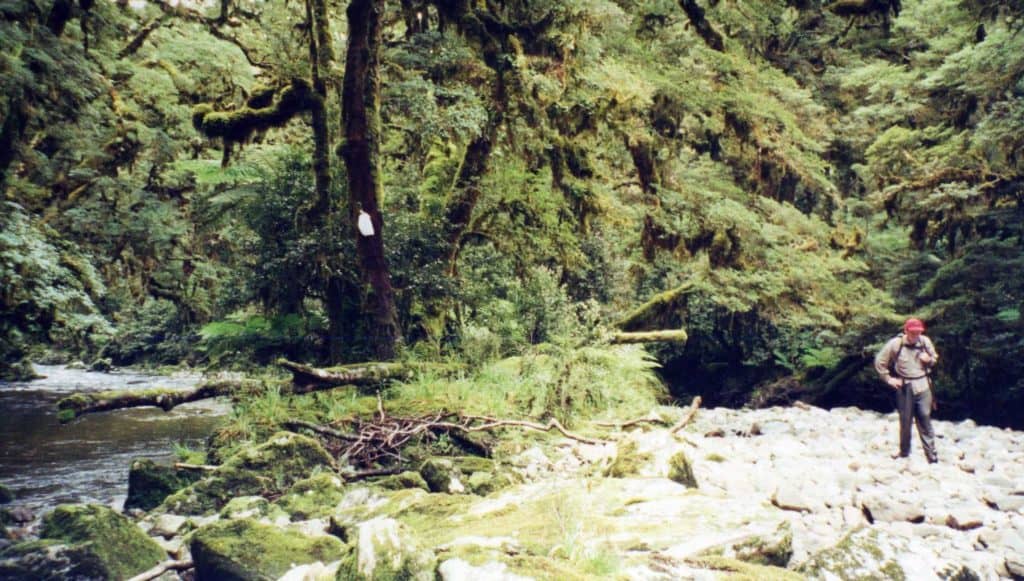
It is quite a large stream, still two-three metres wide up there I guess, and very pretty, though dark. I have been there on a later occasion, perhaps 2006, 2012 or 2013 (I know I was alone; I usually am) and walked as far as the top waterfall. There had been a moose in this valley recently. There were fresh-ish footprints – given the amount of rain the day before they had to have been no more than a day old, and there was quite a lot of browse. We did not see a moose, or any deer but after all, the hunt is what it’s all about. That and seeing fresh sights, some of which maybe no man has seen before, or will again!
A morass in the Waterfall Burn.

I can remember seeing sign there again on a subsequent trip, but what exactly I cannot remember. Browse, marks, droppings…they all blur a bit with time. This year (2017) I realised I had seldom (if ever) actually photographed the browse so I could point it out to people later on (I did not have this blog before, so I had no reason!) There was plenty of old browse in the Hauroko (which I snapped some examples of), then a little barking as I descended into Loch Maree (which I forgot to snap). After that again along the Seaforth there was browse, but by then I had forgotten to take pictures altogether. You just get to enjoying the experience, thinking about other things etc. Last year I walked almost all the way back down from Everest without taking a single photo, though I saw many things I had not noticed on the way up. I had pneumonia is my excuse, but I doubt I will be going back to capture those missing snaps.
For example, in 2006 I took this snap of a couple of ducks. Look behind them though and you can see the height of the browse line on the shiny leaved tree on the right.

We walked back towards the Hilda Burn. The walk wire was out when we were there in 2000 so we had to walk down along the stream to the bottom, cross there and walk along the beach to the hut if the tide was high. If it was a bit lower, we would cross as much of Supper Cove as we could, then cut inland towards the mouth of the Hilda Burn, so our route was a bit different each time, always walking off-track.
And that afternoon, in the fading light we found where the bull had been when we heard him call! And he had clearly been camped there for a couple of days, pretty much in sight of the hut – so much closer than we had estimated. But he was not there now. Probably he had gone up to join the cow at the head of the Burn! So much country. And it is utterly impossible to ‘track’ anything in that country. All you ever see is the odd print. The eternal moss swallows everything up, including sound.
There is this, though. That was 17 years ago now: a pair of moose within a stone’s throw of the Supper Cove hut. If you imagine that they managed to breed every year, even if the mortality rate is very high or the fertility rate very low there have to still be a number of moose within ‘cooee’ of the mouth of the Seaforth. There is still food for them there, and every time I go I can see browse I did not see the time before. Every time I go, I find ‘fresh’ moose tracks. Conditions in Fiordland are such that you just won’t see prints that are a week old. There are just so many places they can easily travel with their long legs and wonderfully constructed feet where no man could possibly go. Because they are so tall they can reach food on precipitously steep slopes where red deer would have no hope.
I think it was not until the second day on that first trip that I began to notice the moose browse, despite having found moose droppings and spied some moose footprints – and having been looking hard. It was not until I came down with an itchy back probably from a sandfly my shirt had failed to stop, (it had these odd vents with too large insect mesh) and had sidled up to a tree to scratch the middle of my back that, as I did so, my neck craned up and I began to see this characteristic branch breaking and snapping, oh – so far up! Being used to sambar or red deer browse one just automatically scans the forest at just that height, but these big boys easily reach up more than a couple of feet higher than ‘our’ deer.
Brett pointing out some moose browse:

Another day on that trip (there were not many more, worse luck) I walked around the point of land on the other side of Supper Cove against the river before the Waterfall Burn. Many of the coprosma trees on the point had been snapped off at just the height moose love to browse 8+ feet. There was no other sign. I thought at the time maybe they were driven lower down like this in the coldest weather as sambar can be somewhat in our mountains, (There are even times that Supper Cove freezes over!) but I have since found plenty of fresh browse lower down and misdoubt now that moose suffer at all from cold. It was just a silly thought really. With moose the opposite is the case, I suspect. They suffer more from hotter weather. NZ summers of 24C or the like can perhaps be quite uncomfortable for a large Arctic animal. It is then, I suspect they spend a greater part of the day lying up in cool deep pools in the burns where the few that have been shot over the years were almost invariably taken.
That day we continued up as far as the ladder just above the McFarlane Burn looking for Michael who had stayed out overnight without explaining himself, so we were a bit worried – but he is an old bushman. He had a small tent (we knew) and his sleeping bag. So, of course he was fine. He had even managed to light a small fire. Well done indeed. On the way up in the middle of the track we saw an old mark we thought might have been a moose, but it could have been just several deer prints over each other some time past.
In just about the same spot quite near the Old Supper Cove hut site (which is where the track rejoins the Seaforth above the Henry Burn) I have on a number of occasions seen a relatively fresh moose track: once I would say that morning’s – if it had been a sambar we would have tried to start the hounds on it once – and on another occasion about a day old, I guess. So the moose do still hang around their old haunt, the Henry Burn, or ‘Moose Creek’ as Herrick and the other old-time hunters used to call it.
Brett and Michael meet near the McFarlane Burn:
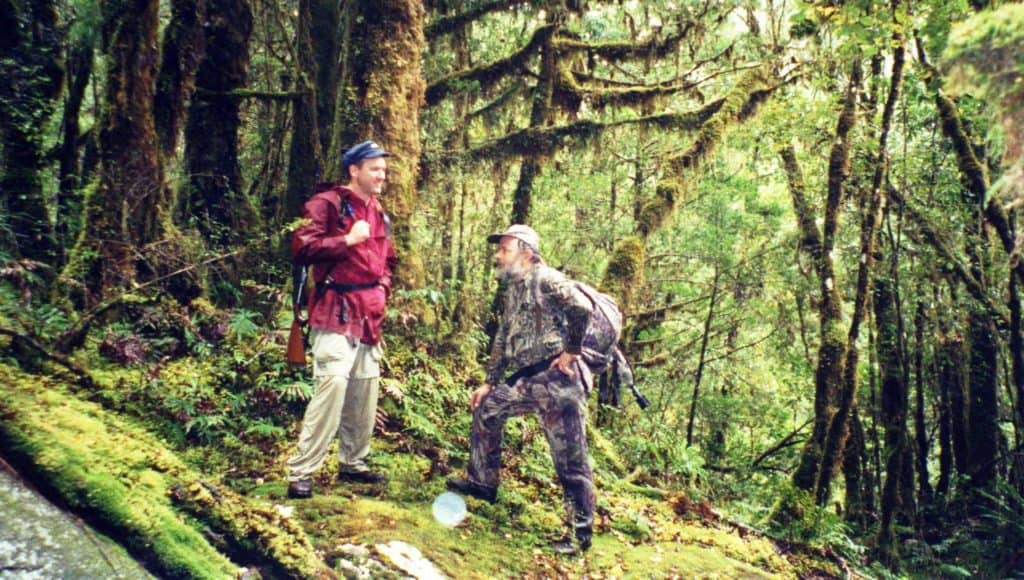
Old Supper Cove Hut site – you can still see the tree fern trunks which formed its floor. A pity they did not leave it standing as it was an important survival shelter – and of historical interest!

I was quite hooked by Fiordland and the Dusky after this trip and vowed to return as often as I could, an ambition with which Della fortunately concurred. It is not every man who has such a splendid wife, I know. What I have done to deserve such good fortune is a mystery to me – may it long be so. Well, it has. But circumstances (and finances) intervened to mean that it would be six years before I could make the trip again. I had returned from the first trip with a reasonable 8-point red deer rack by the way – but I have never taken a gun again. I think the moose need as much chance to breed as we can give them. Besides, guns are very heavy – weighing as much as a week’s food really.

In 2006, I decided I could get away for a short trip (a week – if you are a farmer, a week away is an eternity). I decided I would fly in to Supper Cove, stay a couple of days then walk out. I had no idea even if I could do this at all at the grand old age of 56! The track brochures warned how hard it would be, and recommended only fit young folk should try it, & etc. Some of them even die. Fortunately I am young at heart, as I was still able to complete the trip this year at 68!
This was to be my introduction to ‘ultralight hiking’. I knew that the weather could make a short trip much longer. Also I did not know whether at my age I would be able to make the distances between the huts, and might have to camp out most nights if I was going to be safe. I had already reasoned that a hammock and tarp would be the safest thing to camp in in Fiordland, so we had been busy making prototypes and had come up with a home-made 2 oz/yd2 hammock and a 1.3 oz’yd2 silnylon tarp to go with it. This arrangement then weighed around 7-800 grams altogether, less than half the weight of any tent I owned or could have bought I must say, and much lighter than anything then commercially available as well – even if they did look a bit amateurish. I had camped out in it lots of times in the Gippsland bush, so i was quite confident in it.
This is the wonderful ultralight hammock I am now using, a Hummingbird: http://www.theultralighthiker.com/a-hummingbird-in-the-hand/ Photo is on the beach between the boat shed and the helipad, Supper Cove. You see what I mean about being able to just camp anywhere (If there are trees) with a hammock!

I bought a Gossamer Gear G4 pack at 450 grams (which I still use sometimes – it is too large for my kit nowadays), and I think back then I was still using a Snugpack or Vango synthetic bag which weighed around 8-900 grams (not my sub 600 gram Montbell I use now). I had discovered metho stoves by then, so that was down to a 7 gram model from Minibull plus home-made aluminium flashing windscreen. Back then I used to make fried bread (or Johnny Cakes) every night for lunch on the trail the next day, so I had figured a way to make the stove simmer though I can’t remember now what it was! Though quite tasty, it is a bit of a tedious process making ‘bread’ which I have since then largely abandoned. I will do a post about it in the future though, as it is an important skill, especially if you really like bread! I had moved up to a new digital camera, a Pentax Optio S40 with a 3X zoom which only weighed about 100 grams (saving at least 400 grams on my old film camera).
Back then I was still wearing either Redback Alpine Hiker leather boots (or their Blundstone equivalent) which weighed 600-650 grams dry and about another 50-100 wet, so actually much better than most boots folk still wear today. They are a good, tough boot and if you want a leather boot, I swear by them. In over thirty years they have never let me down. I had earlier moved down from ex-army wool shirts and trousers to Columbia nylon shirts and pants. They are vastly lighter, but your upper body especially gets dreadfully smelly wearing them (even when you wash them and put them back on again wet as I used to do then, even in Fiordland!)
When the weather is sufficiently cool (which it almost always is in NZ), I would now wear either an Icebreaker of a Kathmandu light woolen shirt which you can wear for a week without washing (yourself or it) and never mind getting downwind of yourself, though others may disagree! I think back then I still used my lovely Snugpack synthetic coat which probably weighed as much as 6-700 grams. I was stronger then. I was probably using one of Big Agnes excellent inflatable mats which weighed just under 600 grams from memory, but I might ave skimped and taken a Thermarest self-inflater I suppose which weighed a little less – and was a lot less comfortable besides. And a lot colder in colder weather I might add. I have a lighter, better kit now I think. See eg: http://www.theultralighthiker.com/a-gorilla-in-the-hand/
On the first day up from Supper Cove to Loch Maree, just as I was about to pass opposite the Roa Stream which is on the other side of the river heading upriver (ie on the true left bank), I heard something in the water like a deer clattering across (going I’m not sure which way) and which given the prevalence of red deer there it often is. I have rarely managed to get a photo of them as they usually make off pretty smartly just like sambar in the dense bush. By the same token a hundred metres or so later on at about the point that the noise in the river was, there were very fresh prints of a huge animal crossing the track. It had clearly come out of the Roa stream, and crossed the river and passed just in front of me, and gone very obviously around the edge of the swampy bit on the true right bank (not a bad place to camp actually) and then up into the bush on my left. And not very long ago.
You might think a swampy bit like this would be attractive to a moose, but they are a forest creature. This one skirted this particular swamp opposite the Roa Stream.

I could not really tell whether the splashing and the tracks were one and the same. I did have a bit of a look around for it for maybe an hour, but as I could not be sure whether the tracks might have been made earlier that morning or just as I approached, I did not spend a lot of time on it. It wasn’t just standing around waiting for me to take a pic of it at any rate. It is a seven hours plus walk for me (then) to Loch Maree, so I pressed on, still arriving after dark in fact, as I have done on a couple of occasions.
It is a long walk, particularly if the tide is in and you can’t take the ‘short-cut’ across the Cove. Later on I was talking to Ken Tustin on the phone. He told me that he and his wife Marg were on that very day high in the Roa stream finding lots of fresh moose browse, so I think it is very likely they pushed this guy out the bottom of the valley and across the track in front of me. This suggests a strategy to me of how a couple of very fit young people might get a snap of a moose – but it would be a pretty wild chance, I guess – and depend on there being more moose there than may be the case.
My purpose on this trip was merely to see if I could walk the Supper Cove to Manapouri ‘leg’ of the Dusky Track which I was very pleased to have managed in four long days when I finished, even managing a cold beer (and a much needed shower) on the evening of the fourth day! I saw no-one the whole trip, (so I did not have to share the meagre ration of Bacardi 151 rum I then carried) something which I always find very pleasant!
I really enjoyed the trip and purposed to take my oldest daughter Irralee with me the following year, which I did. In 2007, when we arrived at the Supper Cove hut we found that we had missed the resident moose by about a week. There was an awful lot of moose browse all around the hut, trees snapped over all around and some barking behind the hut, just in back of the toilet. Another hunter who had arrived the day before in fact pointed the barking out to us. We had no need to have the other browse pointed out. It was right in front of the hut. The tracks were all washed away and the droppings were falling apart – which is how I arrived at the conclusion of being a week late.
Some of the moose browse in front of the hut: Can you spot the twigs which have been bitten right off 8-9′ up?

It would be truly awesome to wake up at the Supper Cove hut and be greeted by a moose outside the window whilst you were eating your muesli for breakfast! That year there was also quite a bit of moose browse on the fuchsia coming down from the slip above the Kenneth Burn to the Gair Loch (on the second day out from Supper Cove), but again it was over a week old.
Irralee is pointing out some Fuchsia browse near the Gair Loch.

Some old barking encountered on the way: 
I again walked the track with my son, Bryn in 2008. There were a couple of spots where we found old tracks (‘old’ in Fiordland probably means at most a day) – anyway the animal wasn’t standing in them. From memory again they were near the Old Supper Cove Hut site (ie near the Henry Burn) and near the Kintail Hut as we were crossing the walk wire over the Seaforth there – quite fresh tracks on the sand there, probably from that morning.
Of course you are always on the lookout for whatever made them, and you make forays off into the bush in the direction they appear to be heading, but the bush is so vast (and so thick) and the moose so sparse that it is a hopeless task, really. All that I can say is that you won’t see a moose standing in the main street in town back home. if you want to see a Fiordland moose, you will have to be tramping around in the vastness of that wonderful forest. I would hope you shoot one only with a camera really. I have grown quite fond of them – from a distance anyway!
A couple of examples of some barking we found.

This looks like it is probably only a week old at most. Usually/oftenthe barking is much higher, 7 or 8 feet.

The browse around the Supper Cove hut (and the barking) from the year before were still clearly visible (and identifiable) a year later, by the way. In fact two years later, as my daughter was able to point it out to me on our second trip there together in 2009.
You can still see it here in 2009 with a fantail sitting on it.

Bryn and I watched this red deer stag (centre) as we were crossing the Henry Burn. A decent zoom on a waterproof camera would be a plus! You will spot him eventually! Quite a big fellow really.

I canoed the Seaforth in 2009, probably one of the silliest things I have ever done. As I was portaging around the shores of Loch Maree – I was walking along the shoreline so I might see any prints rather than walking the track; the water level was low enough to do so that year – they were having a drought in Fiordland. It didn’t rain for the whole 13 days we were in the South Island altogether! Some of the trees in the valleys were browning off, something only real old Fiordland hands had ever seen before. Anyway, I came across an old set of moose tracks around about where the walk wire about half way along the Loch is. As it hadn’t rained for ages, they could have been over a week old. It had just come down to the Loch for a drink, then headed back up the little valley it had come down from.
I was at Supper Cove again in 2011 with Della, but we had to leave precipitously only about an hour after we arrived as Della managed to dislocate her shoulder slipping off a rock. Ouch! Thank goodness for helicopters! No moose that year!
I walked the track again in 2012 in company with a young American, Steve Hutcheson I met at Supper Cove and an Israeli, named Renan Tsorin. Steve and I had about five days at Supper Cove, him fishing and me tramping around in the bush looking for moose. I remember I found some old tracks on the ridge above the Supper Cove hut and in the Hilda Burn – and obviously some browse. I found the same thing along the Henry Burn. I guess I walked nearly half way up it to the fork you must follow if you are to walk over into Herrick Creek – so probably to about the place a couple of the Fiordland moose were shot, long ago. No sign of them now of course.
Here is a (very) old print (the triangular indentation above the glasses case) all filled in with leaves. This would have to be about as old as you are going to be able to see a print in Fiordland – say over a week. This one was over a kilometre up on the ridge behind the hut

Looking down towards the fiord coming down from way up there. The going is pretty steep:

Particularly above Loch Maree along the river on the true left bank there was a lot of moose sign, mainly older browse – say up to a year old. I walked along the river for about three kilometres by myself above the Loch Maree hut and up the Deadwood Stream a bit before crossing over to the track. The young fellows following the track were quite surprised at how I managed to get ahead of them! The river level that year was again very low, so I could do this (and avoid a slow, nasty section of track for the first hour upriver out of Loch Maree). I figured this moose was a resident of the Deadwood Stream which looks big enough to hold a number of them! There was old browse here and there along the river that year – but no tracks.
The moose browse is both higher (as much as 3 feet higher!) and on much thicker branches than deer browse. They bite right through stuff up to I guess over 1 cm thick. When they grab and break over even thicker branches (say 2cm thick) in order to strip them, you can see how their powerful jaws have shattered the branches longitudinally.
However as we walked up through the huge slip above the Kenneth Burn, a moose had walked along ahead of us barking the trees quite obviously. I remember pointing this out to Renan, using my fingernails to mimic the action of his giant teeth, and angling my head to indicate how he must have made the bites. This barking was sometimes I guess 9 feet up! I must look a circus sometimes. I wish I had taken photographs!
Then, just about where the saddle is before you start to go down again to the Gair Loch, there was a patch of fuchsia on our right which had been the home of a moose for I’d say the best part of a week. S/he had had a really good feed on I guess and acre or two of fuchsia. Anyone who doubted the continued existence of moose in Fiordland would be hard put to explain the extent of its high foraging activity there. I remember a couple of days later I was walking with Steve in the Upper Spey and also pointing out to him some very old moose browse there – in the vicinity of the Dashwood Stream.
This is part of the huge Fuchsia filled slip above the Kenneth Burn where a moose had been browsing for days in 2012. Plenty of food here.

It is a huge area of Fuchsia. There are many such in Fiordland – few as easy of access though. Look hos steep some of it is – near the waterfall!

I had a back operation in 2013 so any Fiordland trips were out that year.
I spent a few days by myself at Supper Cove in 2014 (flying both in and out on that occasion). It was lovely to have the hut to myself for a few days, to go out in the morning exploring the bush around about and in the afternoon catching myself some blue cod for my supper. The most delicious fish anywhere, trust me. Do bring a hand line and a fry pan if you venture that way. I was going to walk out, but on the very last night before the day I would have to leave the next morning of, a party of twelve young people arrived even though none had been there for a month! Of course I tried to persuade them to stay a day and do some fishing (even offering them my line, etc), but they insisted on starting out the next day as well.
All alone in the Supper Cove Hut

I could spread out.

And enjoy some tasty blue cod for tea.

Well one night in a crowded hut with people whose heads were filled with the usual certain certainties of the young was enough for me, so I called up Alan from Wings on Water (who had brought me in) and flew out again. I used the couple of spare days so gained to go have a look at the start of the South Coast Track (out of Tuatapere) walking out to Port Craig and back whilst I was there. I confess I was hurrying along this section – and even walked the beach ‘track’ all the way from the Hoka Stream. I was not looking for moose sign as I thought this was too far from their ‘normal’ haunts. I was just checking out the track thinking it was probably easy enough to take Della on the next year. (it was). I was surprised therefore when I spied (on the return trip of course) a small example of moose browse quite close the the shore somewhere after the Track Burn – before you begin the climb up the innumerable steps to the Rowallan. It was well off the track but you could see the characteristic branches snapped off so high up. Surprising really as there are a number of hunter’s huts in this area. It is a popular locale for deer and pig hunters – but I guess it is seasonal.
Della and I attempted to walk out to Westies Hut along the South Coast Track in 2015, but got only as far as the Waitutu River as it turned out, because of Della injuring her knee. We rested up and did walk all the way back to the Rowallan though. The same old browse I saw the year before was still there, but I confess i was just not looking out for moose sign along the way – I was looking out for Della!
We headed back out on the South Coast track again in 2016 intent on beating it this time, and getting all the way to Westies or even Big River. Westies as it turned out. It was a lovely trip, our reports of which you can read about eg here: http://www.theultralighthiker.com/a-walk-in-fiordland/ You should really do it! Again, I was mainly intent on looking after Della (who is partially sighted – 39%) to be paying overmuch attention to moose sign, though there was a bit of old sign about here and there – I noticed some for example a little over an hour out from the Waitutu heading for Westies.
When we were walking out from the Wairaurahiri with Pete Baldwin from the wonderful Waitutu Lodge at the Wairaurahiri Mouth, I was explaining to him what he should look for if he ever had the chance to get ‘into’ the Seaforth country. Right near the Edwin Burn trestle crossing there was an obvious patch of old moose browse, the branches snapped over and stripped in their characteristic way about 8′ up, but maybe 1-2 years old. Nothing else could possibly do such a thing. So, there are moose that far East in Fiordland yet.
I have now realised that I smelled a moose in the Hauroko Burn last trip (back in April 2017) and I am really kicking myself for not having stopped, camped and investigated See: http://www.theultralighthiker.com/follow-your-nose/). As I said there: ‘I have a confession (of stupidity) to make. Somewhere during this section between the two upper walk wires on the Hauroko Burn, Fiordland, NZ (You can imagine it is in the photo below) I encountered quite a strong ‘animal’ smell not unlike a goat. I recognised that goat smell instantly having had the largest dairy goat herd in Australasia back in the 1970s. I thought to myself at the time, ‘Well, it’s not a deer’. Then I thought, ‘Could it be a plant?’ You know how Dogwood in Australia is so named because it smells somewhat like wet dog. I thought to myself ‘I wonder whether the Leather Wood which you encounter just before the tops in NZ (and which is redolent with the musty odour of countless red deer) is so called because it smells of leather?’
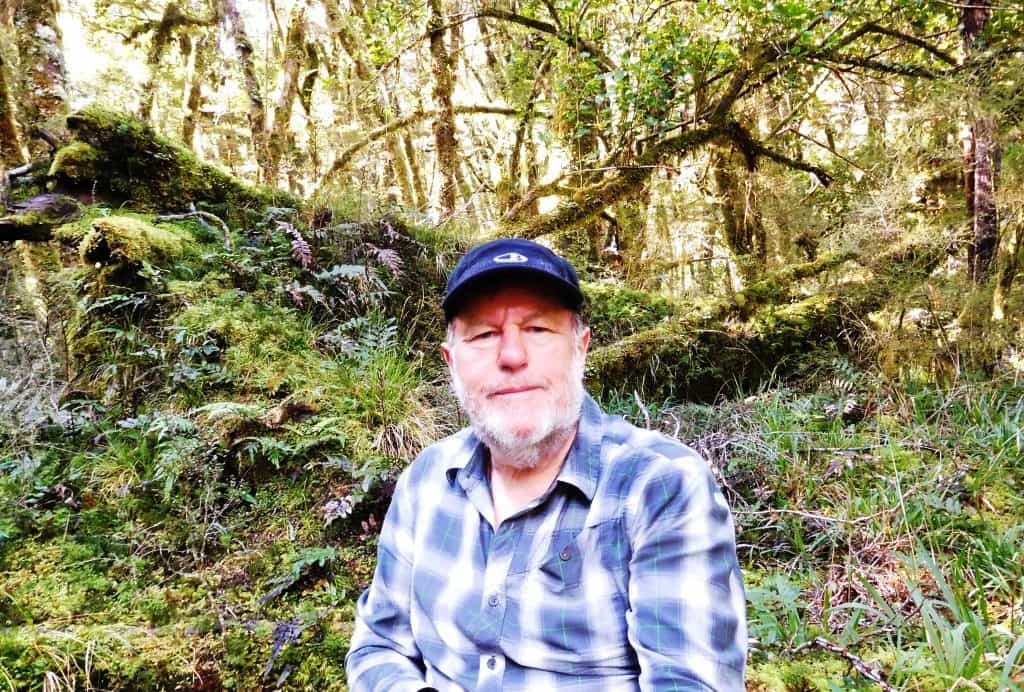
There is another odour – a sweet cloying honey-like smell you sometimes encounter in these Fiordland forests I have never been able to identify, nor has anyone else I have spoken to been able to pick it for me. (it is not the flower of the ubiquitous tiny epiphytic orchid). It was not that though.
I am pretty good on scents having been a hunter all my life. I instantly galvanise to a whiff of fox, roo, wombat, stag, goat, etc. But I knew it could not be a goat or a deer. Possums are common in our back garden. It was not one of those. My father had many ferrets when I was a youngster. It was not a stoat. But what was it? As i said, there is this other smell in the Fiordland bush I had never been able to identify either.
I scanned the forest about. Saw nothing. Thought to myself, ‘I do not want to arrive at Lake Roe in the dark’ (The hut is hard enough to find as it is, particularly in thick cloud, being off the line to the right); I am old and also had a long way to go, so I carried on. Since then, I have bothered to check what a moose smells like. You guessed it. Goatish. Just like what I was smelling on the Hauroko that day! Damnation!
There was a moose not 200 metres upwind from me, and I walked on. Despite having a tarp and hammock and more than a week of food, so that I could have spent days hunting it! And I would have doubtless ‘put it up’ withing ten minutes! Dream on! Despite the fact that one of the important reasons I go there is to see a moose. Despite the fact that I had photographed fairly fresh moose barking just back there a little (as you can see below). Despite the fact there is a $100,000 reward for a photo of a NZ moose, I walked on! Lesson: Trust your nose!’
When I think back to the one in the Hauroko I now realise why I could not see it. It was most likely below my level of vision lying in the stream bed just as the one I put up in the Hilda Burn was 17 years before – why the idea never occurred to me then when I could smell it, I have no idea.
My knee is still not right from an injury in the Hilda Burn on that trip which brought an early end to my off-track explorations then (there was still old browse in the Hilda), so I am wondering about my future ability to do so again, but I am working on it – an hour every morning in the gym and an hour every afternoon walking – on top of my normal farming activities, but at just shy of 70 it takes longer to heal and to get fitter again. Every day though I feel stronger, and have just completed a six day off-trail hike in the Vic mountains, and climbed Qld’s tallest mountain, so there is hope!
It was interesting that the Hauroko was nearly eaten out, but with lots of old sign (and clearly a resident moose!) And that there was a ‘bloom’ of new plants coming up I had not seen in Fiordland before) Yet coming down from Lake Roe to Loch Marie for example, there was oodles of moose plants without much moose sign at all – though some barking. Clearly the moose are fairly light on the ground. Each likely has an enormous territory, perhaps 2-500 hectares or more, but that still adds up to a lot of moose in Fiordland National Park!
I had this note about the moose on the first of my posts about my 2017 trip: http://www.theultralighthiker.com/from-dawn-to-dusky/
The Elusive Fiordland Moose: Along the way there is sporadic moose sign if you are alert and keen eyed. Nothing else could reach up 2.5-2.7 metres (8-9′) and more, break off branches as thick as your thumb and strip them, or devour all the lower vegetation of their favourite broadleaf plants, or systematically bark trees, or leave footprints as big as a cow’s.These solitary leviathans yet roam these forests unseen. I took these shots in an arbitrary few hundred yards walking up the Hauroko.
This coprosma has been systematically broken off over 2.5 metres up.
NB I measured the tip of my hiking pole in my loungeroom held out like this so I could take a photo with my other hand at pretty close to 9′. No other deer can reach within 18″ of this height!
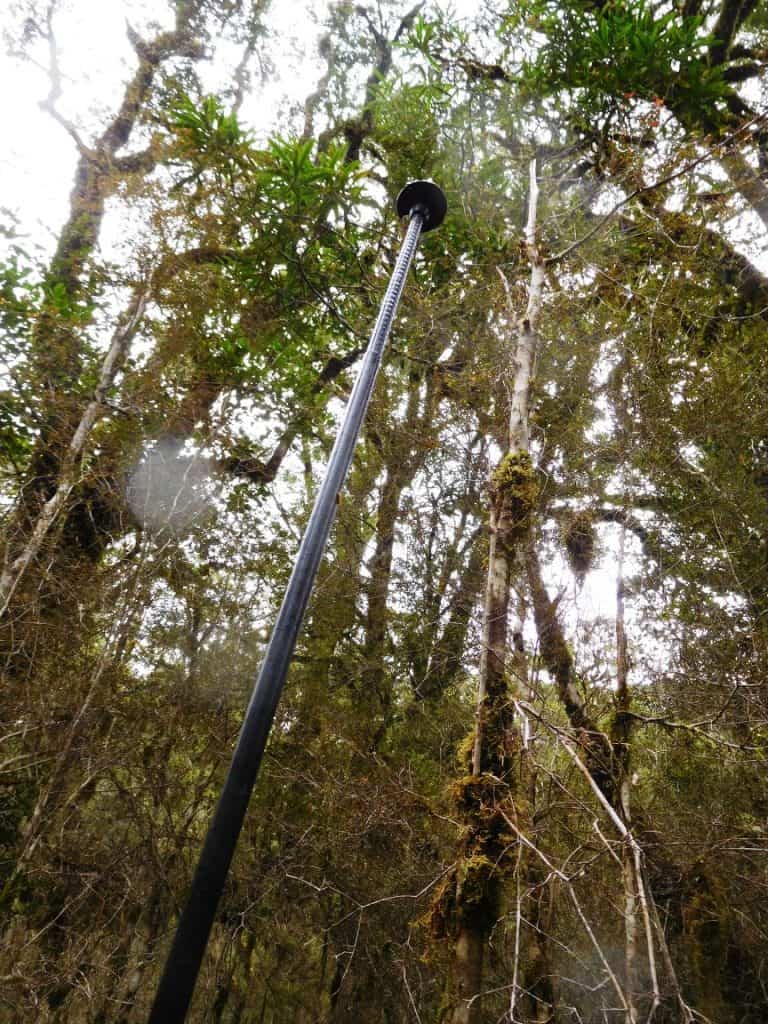
And this.
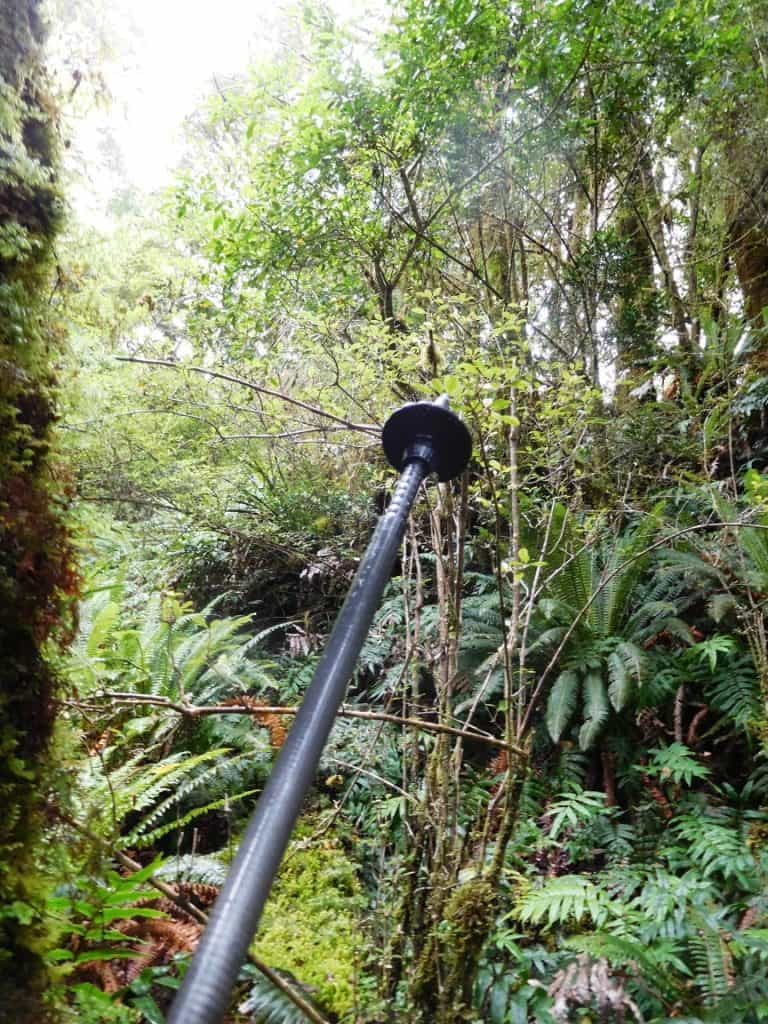
Broadleafs have commonly been stripped to this height.
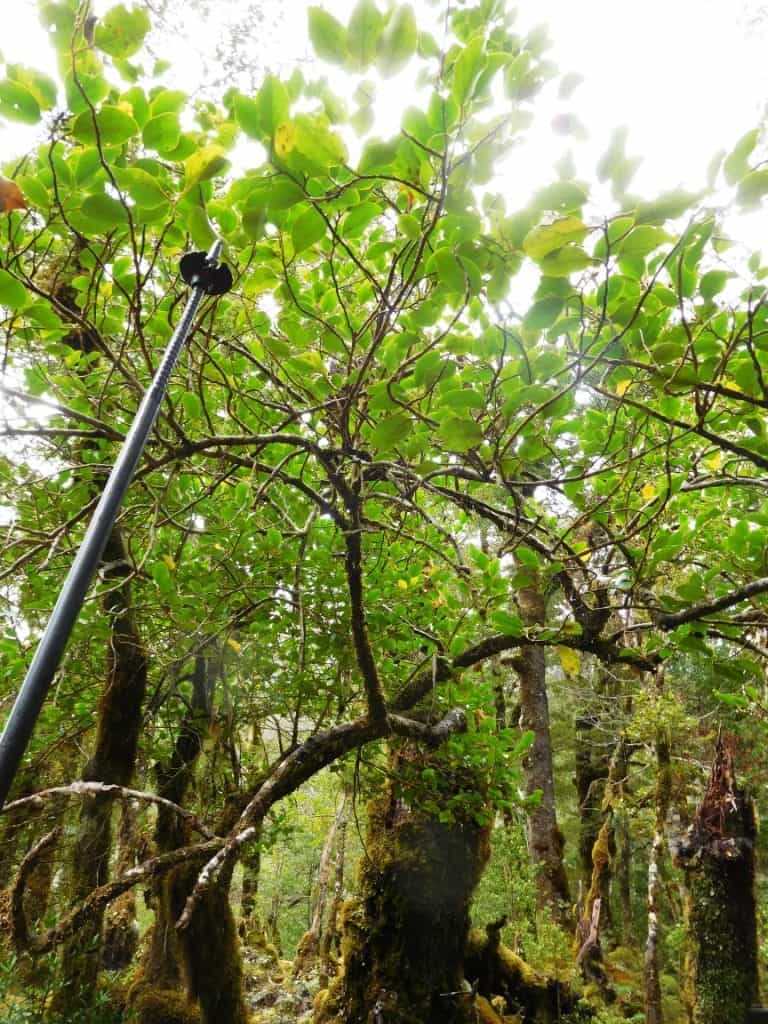
They like to snack on nutritious bark as they amble along.
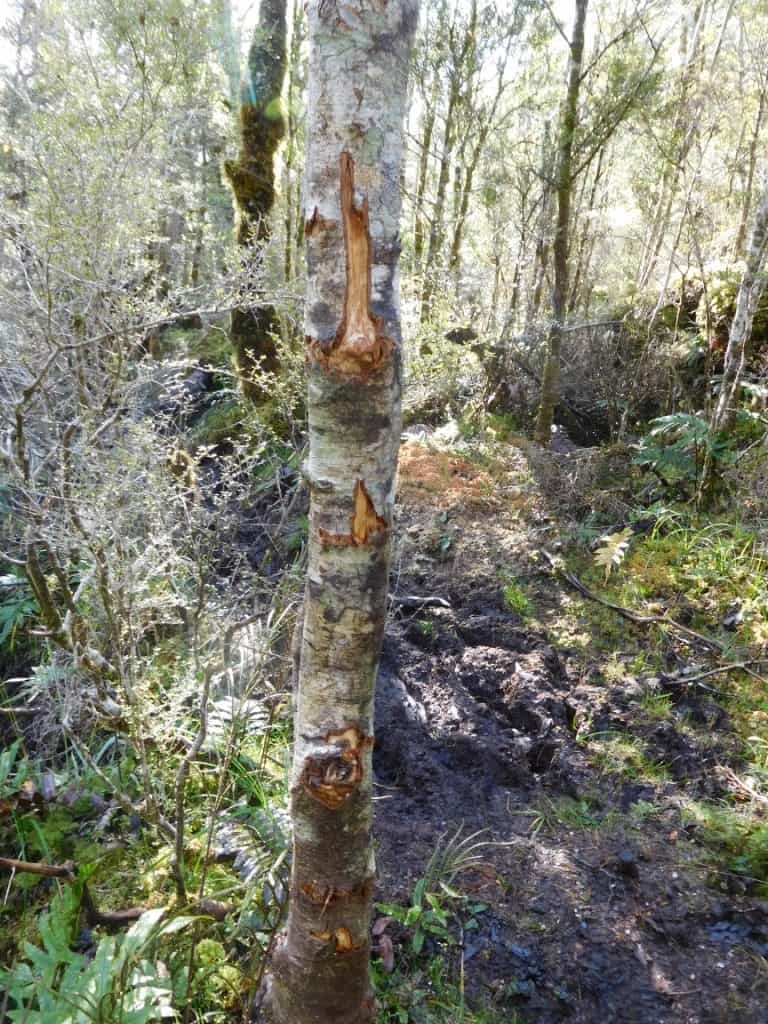
Leaving footprints as long as my glasses case. Like this:
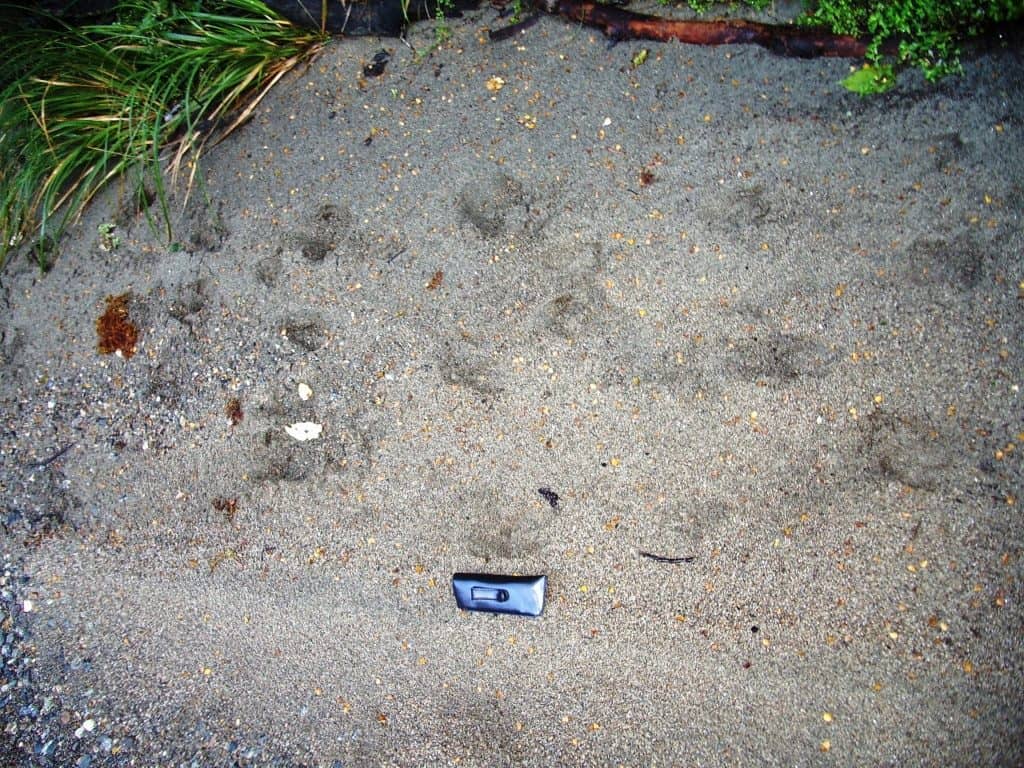
Or this.
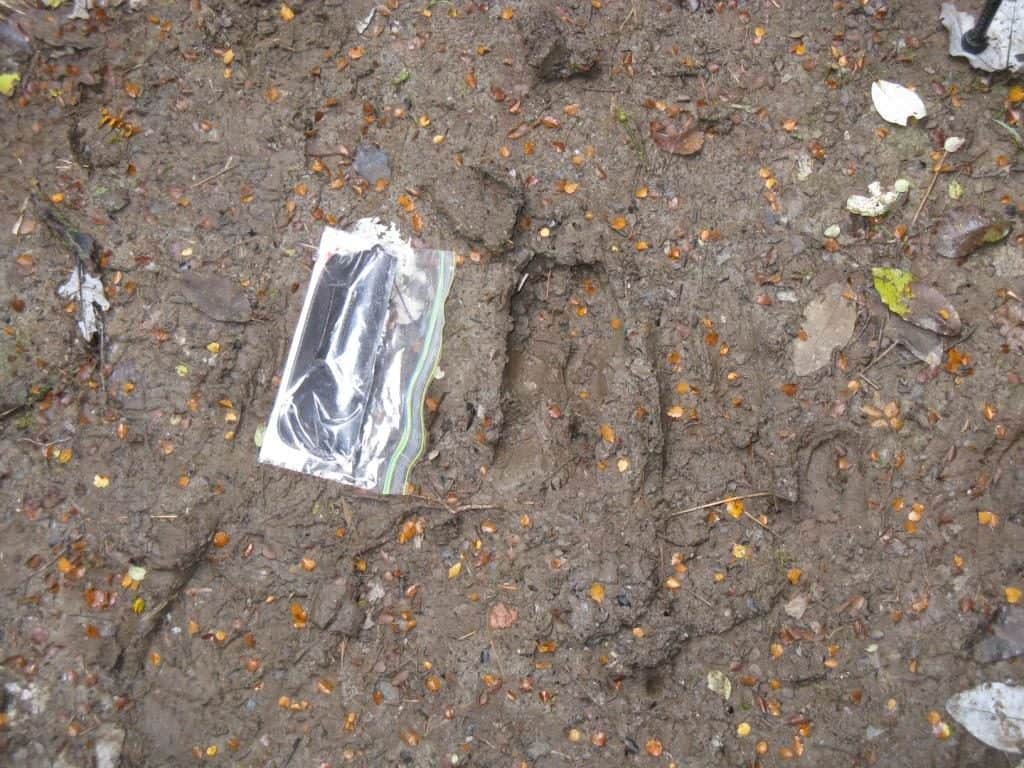
Someday someone will stumble round a corner onto one and snap its pic. A girl from Scotland wrote in the hut book way back in 2000 she had seen one! Already two confirmed C21st DNA samples have been collected, and one or two indistinct photos. It is only a matter of time…
I don’t know at this stage whether I will be doing a lot more ‘moose hunting’ in Fiordland. Mostly these days we go there for the walk anyway and because it is just so beautiful. Any moose we see would no doubt be a bonus – and we surely won’t see them elsewhere! I do have a couple of ‘new’ ideas on how we might find further proof of the continued existence of the NZ moose herd. More about that later.
And oh, I have been thinking about Ken Tustin’s theory that the red deer will ‘eat out’ the moose. I now suspect the opposite is the case because the moose can reach higher, and will obviously break branches down for their young. You can imagine the young moose nearing weaning – they suckle for a long time too – straining upwards as its mother feeds and vocalising, every now and then being able to snag a leaf she lets drop & etc. They are messy eaters at best. I figure she would get the idea and help it feed. They routinely ‘walk down’ trees for themselves, for example. I remember noticing this phenomenon the very first day I was in Fiordland (in the Hilda Burn back in 2000) and wondering what could have produced the phenomenon I was seeing. I had never seen anything like it in the Victorian bush despite it being overrun by sambar deer who are very keen browsers too.
I have noticed that in the areas which appear more eaten out (by moose and everything) that the moose browse seems to consist of more branches actually broken off completely whereas in the less eaten out areas, they tend to be just broken over. I need to spend more time there to confirm this, something which may not happen in this lifetime.
I realise I do not know how this ‘boom and crash’ population dynamics works (with any creature) though, so maybe I am wrong. I am not a wildlife biologist, but I have been a farmer and hunter for a long while. Some places look very eaten out by deer, particularly along river banks and near huts and other clearings, yet in other steeper places there is little sign of any grazing animals. Another interesting observation: along the Hauroko for example, there is this shiny leaf tree which moose obviously like. In many places it was browsed lower from the river bottom than it was from the river bank (but in each case as high as a moose could reach ie 8’+ up) giving it a lopsided appearance. I had not noticed this before. No doubt there are lots of other ‘signs’ which escape one’s attention for years.
Here is a tree moose quite like, (I don’t know what it is called). You can see that this one which is hanging out over a precipice (in the Hauroko) has still been browsed ( a long time ago) as far as a moose can reach out, and certainty further than anything else could.
Here the moose has been walking along in the stream reaching up and has mown these trees to a precise height. They have even managed to strip some of the branches hanging down. You see this everywhere. We went down the Wairaurahirti River in a jet boat (twice – and Della wants to go again, and again. So should you!) Anywhere this plant could be reached it was trimmed to about 8-9′ from the ground (or where a moose could stand) , but where nothing could reach it (eg in a very deep rapid) it was actually touching the water.

In 17 years I have not been able to get back to Fiordland in the summer. By the time we have been able to stop watering our garden and watching out for the ‘bushfires’ that a ratbag collection of maniacs have taken to lighting every summer in our part of the world it is at best late March, usually April, sometimes May. And of course I am often there when the ‘Roar’ is on so every moose has been scared well away from the valley bottoms by ubiquitous deer hunters. It’s like always going sambar stalking on a full moon, or in early Spring when the deer have moved back from the valley bottoms (as fresh feed pops out from under the snow – and the young are born. Not such a good time for hunting.
I do always find old sign though, sometimes not that old even. I am convinced if i could spend several summers walking along in the streams there I would put up another moose. I’m not sure whether at my age I can do such hard work in hot, steamy weather, and I don’t know whether I will ever be able to get away at such a time or not.
Perhaps!
PS1: I wrote this article at Ken Tustin’s request, as he is preparing a new edition of his book/a new book about the Fiiordland moose. He and he wife are the true moose experts and heroes of this interesting saga. More about them here: http://www.theultralighthiker.com/nz-moose/
PS2: To ‘keyboard warriors’ out there who have annoyed me with your thoughtless comments on your chat forums about my ‘mythical’ moose: I know the difference between moose and red deer sign. I have spent over 40 years hunting deer. The high sign I am identifying as moose is several feet higher (and thicker) than anything attempted by the largest sambar or red deer stag – similarly the very large prints and droppings I am talking about. Take a closer look at these two sets of droppings, for example.
The moose droppings are on the left and centre. The ‘tiny’ droppings on the far right are normal sized red deer droppings approximately as large as the first joint on your little finger. If you can see evidence of their mouths and of their rear ends, there has to be a moose in between somewhere!

And as I said before, there have already been several positive DNA identifications of live moose this century from Fiordland!
PS3: The ‘Cover’ photo was sent to me from Sweden by my son, Bryn on this day (24/10) 2011. He must have known I would find a use for it! European moose are smaller than the Canadian moose which live in Fiordland, by the way.
PS4 March 2020: A moose has just been spotted in Doubtful Sound: https://www.theultralighthiker.com/2020/03/04/new-evidence-of-fiordland-moose/
First Published Mar 5, 2018
See Also:
http://www.theultralighthiker.com/hunting-in-fiordland/
http://www.theultralighthiker.com/from-dawn-to-dusky/
http://www.theultralighthiker.com/from-dawn-to-dusky-day-2/
http://www.theultralighthiker.com/from-dawn-to-dusky-3/
http://www.theultralighthiker.com/from-dawn-to-dusky-4/
http://www.theultralighthiker.com/from-dawn-to-dusky-5/
http://www.theultralighthiker.com/from-dawn-to-dusky-7/
http://www.theultralighthiker.com/from-dawn-to-dusky-8/
http://www.theultralighthiker.com/insects-can-ruin-a-camping-trip/
http://www.theultralighthiker.com/dusky-track-canoeing-the-seaforth/
http://www.theultralighthiker.com/dusky-track-adventures-1/
http://www.theultralighthiker.com/eddie-herrick-moose-hunting-at-dusky-sound/
http://www.theultralighthiker.com/eddie-herrick-moose-hunting-at-dusky-sound/
http://www.theultralighthiker.com/a-friend-i-met-on-the-dusky-track-fiordland-nz/
http://www.theultralighthiker.com/dusky-south-coast-tracks/
http://www.theultralighthiker.com/dreaming-of-the-dusky-track/
http://www.theultralighthiker.com/the-dusky/
http://www.theultralighthiker.com/moose-hunting/
http://www.theultralighthiker.com/fiordland-moose/
http://www.theultralighthiker.com/fiordland-moose-2/
http://www.theultralighthiker.com/hunting-in-fiordland/
http://www.theultralighthiker.com/off-to-fiordland/
http://www.theultralighthiker.com/shadowland-fiordland-video/
http://www.theultralighthiker.com/the-best-toilet-view-in-the-world/
http://www.theultralighthiker.com/10-days-in-fiordland/
http://www.theultralighthiker.com/fiordland-2009/
http://www.theultralighthiker.com/fiordland-nz-with-bryn/
http://www.theultralighthiker.com/fiordland-april-2007/
http://www.theultralighthiker.com/weather-for-fiordland/
http://www.theultralighthiker.com/more-dusky-adventures/
Some other hunting ‘adventures’:
http://www.theultralighthiker.com/sambar-stalking-101/
http://www.theultralighthiker.com/not-quite-alone-in-the-wilderness/
http://www.theultralighthiker.com/a-wild-river-stag/


Thank you for the interesting article! Found out about you from Joe Rogan`s show (https://www.youtube.com/watch?v=V4fi4i6ixAc). Keep up the great work, wish you all the best!
Kind regards from Ukraine =)
Thank you Volodymyr.
This has been my Friday night reading – so interesting, I’m hooked on the mysterious nz moose. Will continue to follow your blog with interest 🙂
Thank you. Glad you enjoyed. Cheers, Steve.
Thanks for posting! As an Otago lad, every once in a while you hear a story about moose, third or forth hand. Exciting to read your accounts first hand! As a matter of interest, in your years hunting fiordland have you ever encountered sign or evidence of Kakapo still in the area? It’s always intrigued me the possibility that if a moose could hide out, what else might still be there!
Thank you David. No, I haven’t encountered a Kakapo but but I thought I heard a Takahe calling in the Spey River near the Dashwood Stream one year. There are also places in Fiordland nothing (even stoats) can get to. There may be plants or creatures on some of those vertical forests which have survived the onslaught of these menaces. Cheers, Steve.
Hi Steve,
Thanks for the kind words! Your blogs nice too.
I take comfort in the fact that you older fellas are still going strong, because they say life starts racing by once you hit 25 (!) and I sure as hell don’t want to stop anytime soon haha.
I’m usually skeptical of things until I’ve seen things for myself, but I don’t doubt their existence – Fiordland is a vast place, and impenetrable in many places. Other than moose, who knows what else may lurk in there.
If I did stumble across one there would probably be a bit of a moral dilemma with regards to whether I’d shoot it or not. I’d like to think I wouldn’t. But who knows…
Yes, you’re more than welcome to use one of my images!
Looking forward to following ya.
Cheers,
Arash
Thanks Arash. I will, and I look forward to your adventures. It is so much easier when you are young, and so much more hard work when you are seventy! The moose are probably in such low numbers and their survival so uncertain that removing one as a trophy probably can’t be justified as against the survival of the herd. But a photo is much harder to get than a trophy! The other thing you might look for there (and this may well be a myth) is the Fiordland ‘otter’. Many people over the years claim to have seen it. I am personally unconvinced, but many strange things still lurk on Earth. A hitherto unknown type of wild cow was recently found in Vietnam, and there have even been ‘new’ primates discovered this century. Make sure you have at least a satellite Messenger/epirb before you head off into the bush alone. The Spot Messenger is the absolute minimum you should take. If you can afford the Inreach (or a satellite phone) that would be better. The Somewear is the lightest currently available. Sometimes satellite services/equipment even fail to work, but it is very easy to get yourself into a dangerous/life threatening situation alone in the bush. You should probably plan a long walk on (and off) the Dusky Track for example before you head off into more remote parts of Fiordland such as you will find in Moir’s Guide. Being able to keep dry/warm is the most important thing. It takes much longer to starve but you can be dead in one night from cold and wet. A fishing line will get you more food in Fiordland than a gun (and for much less weight). I would provide links to my posts about such things in this comment, but apparently WordPress won’t allow me to. Anyway, have a great time. Cheers, Steve.
Hi Arash. I have done a post about your adventures (and stolen one of your brilliant photographs to illustrate it – hope you don’t mind). Your adventures are beginning wonderfully. Hope you have a great time. Good luck, and happy hunting. Steve.
Hi Arash, I have done a post about you adventures. I have also stolen one of your brilliant photographs to illustrate i. Hope you don’t mind. Things seem to be going wonderfully for you so far. Hope you have a great year. Look forward to reading about your trip – and I’m sure many of my readers 9and others) will too. Good luck, and happy hunting. Steve.
Hey Steve,
I love this Moose story of yours – and your courage to share it with the public.
I’m about to spend at least 6 months or so in the Fiordland bush very soon. It would be unreal if I bumped into one! You can follow me here if you’re interested –
I’d be stoked. http://www.themountaingnomad.com
I think – regardless of whether they exist or not (and they may very well) – our world needs mysteries; we need unanswered questions; and we need people (like yourself, and Ken etc) who are prepared to chase them. The adventure after all lies in the hunt/journey, doesn’t it? So – even if no ‘undeniable’ proof was ever obtained of their existence…those who chase them will still reap the rewards of battling through these harsh but beautiful wilderness places to fulfill their own curiosities.
And that (the sustained and passionate search for answers) is in my opinion a beautiful thing – especially in today’s world which is often fraught with hurry and insistent upon guarantees.
Keep it up until you drop.
Thank you Arash. Yours sounds like a wonderful adventure. I almost wish I was young again. Well I do wish I was young again! We too lived in NZ for a year when we were about your age. You should be able to live very comfortably out of your car. There are also pigs by the way along the South Coast Track, for example. The moose are real. There is authenticated DNA this century for the real doubting Thomases, but if you look at my shots of the browse and droppings I think there has to be a moose in between them somewhere. Besides I have encountered them. I doubt you will manage to shoot one though, but good luck! I will not be shooting one, but I will still continue to look for one, and who knows I may yet get lucky? I’m not dead yet, as Greg said below. I looked at your blog and am delighted with it. Do you mind if I share a post about it? I will have to borrow at least one of your photos for illustration purposes. Cheers, Steve Jones.
I admire your efforts over the years & enjoyed the read!
I am also a nz moose believer, although I’ve never been to fiordland (north islander)
Keep at it, you’re not dead yet.
Thanks Greg – and neither are you. It is such a wonderful place to visit that a very wild chance of seeing a Fiordland moose is not at all necessary to draw me there. I will be back, as long as my fitness holds out! Cheers, Steve.
Interesting read and well done on so many trips.I’m hoping to get there myself next February and begin my moose “quest!”. I’m a full time hunter based in Turangi and I’ve followed the Moose story with much interest.I used to know a old chap who used to drive a bully and was the father in law of a guy whose property I fenced and trapped on,this old chap was Graham Duthie.Graham had done something like 20 plus Moose expeditions and had photo albums full off tracks,browse etc and he told me that on a couple of occasions they were very close to moose but accidentally followed the Moose of reds and the moose slipped away.Ken may have heard of him if not he should try to get a peek at those albums as should you,good read,Ricky :).
Thanks Ricky – and good luck with your own ‘moose quest’. Cheers, Steve.
Awesome read!
Thank you so much – and for taking the time too, Jake. It is so much better than getting the awful slanderous yobbo feedback such as I found here (http://www.fishnhunt.co.nz/forum/YaBB.cgi?num=1524175677) and which upset me considerably. I do dislike such ‘keyboard warriors’. Perhaps if they spent the amount of time I have in the bush, with their eyes and their minds open instead of at home in front of the computer trying to think of yet another nasty thing to say to someone, their lives and the world generally would be improved.